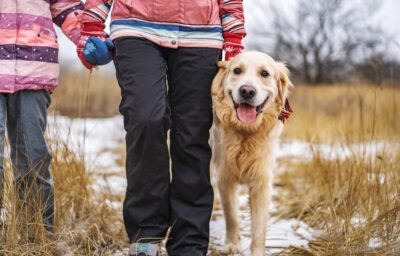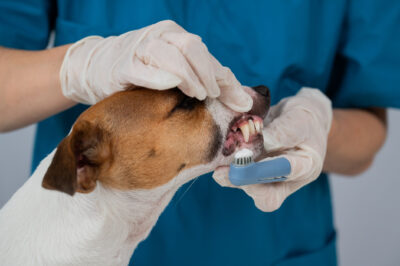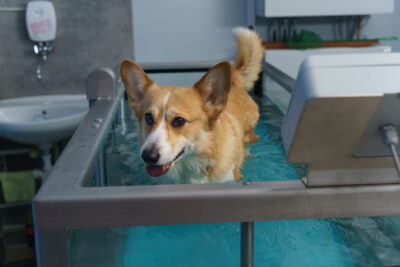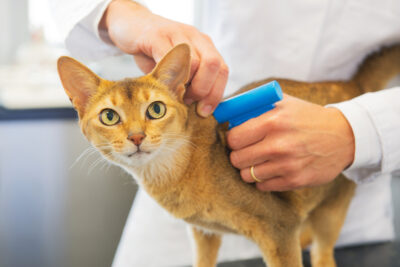How to Groom a Dog at Home

If your dog rolls in something smelly — say, a pile of garbage or the compost heap — giving them a bath is probably a no-brainer. But while some pet parents are seasoned pros when it comes to doggy bath time, others might not know the first thing about how to groom a dog.
So, how does one go about grooming your dog at home? And does it only need to be done on occasion — or should grooming become a regular habit?
“Grooming is essential for a dog’s overall health — not just for aesthetics,” says Melissa Landes of Paw by Paw Dog Training, a Maryland-based dog training company that also offers dog grooming.
According to Landes, regularly grooming your dog can help avoid nasty skin infections, such as hot spots and yeast overgrowth, while ensuring your dog stays free of parasites like fleas and ticks. Not only that, but matted fur can conceal more serious skin conditions or abnormal growths that require vet care, she says.
“Regular grooming helps keep dogs comfortable, healthy, and free from hidden issues,” Landes says.
Read on to learn more about the tools you’ll need, steps to take, and expert tips for grooming your dog at home.
What Does Dog Grooming Entail?

If you take your dog to a professional groomer, the grooming process might range from “a simple bath and brush to a full-service session, depending on the dog’s breed, coat type, and individual needs,” Landes says.
“For example, a German Shepherd may benefit from a de-shedding treatment, which includes a specialized bath using de-shedding shampoos and conditioners, thorough blow-drying, and brushing with tools designed to remove dead undercoat,” Landes says. “Meanwhile, a senior Chihuahua with sensitive skin may receive a gentle bath with hypoallergenic products and minimal brushing.”
But what if you’re handling it on your own? What’s the best way to go about it?
Anna Zege, the cofounder of Groomit for Pets, a New York-based company offering in-home and mobile grooming services for dogs, says that pet parents can follow seven steps to groom their dog at home: brushing, bathing, blow drying, hair cutting, nail trimming, ear cleaning, and toothbrushing. But first, you’ll need to have the proper dog grooming tools!
Tools You’ll Need to Groom Your Dog at Home
If you’ve decided to attempt dog grooming at home, you’ll need a dog grooming kit. Zege recommends stocking up on these essential dog grooming tools:
- Brushes (pin brushes for medium to long hair; slicker brushes for detangling; bristle brushes for short hair)
- Metal comb for detail work
- Dog-safe shampoo and conditioner
- Towels and blow dryer (with cool/warm setting)
- Nail trimmers or grinder
- Styptic powder (to stop bleeding if you cut a nail too short)
- Clippers (with guard attachments for hair trimming)
- Ear cleaning solution and cotton balls
- Eye wipes or sterile saline
- Toothbrush and dog-safe toothpaste
- Lick mat
How to Groom a Dog at Home: 7 Steps
The first step for grooming a dog at home is to choose the right brush for your dog, based on their coat type and the condition of their fur.
Then, begin brushing, starting with the head and working your way down, always brushing in the direction of hair growth, Zege says. If your dog has mats, gently detangle them using a dematting comb or slicker brush.
Step 2: Bathing
Now it’s time for the water part — bath time! While some dogs love their bath, others aren’t so thrilled, so pet parents should be prepared to get wet, too.
Zege recommends using lukewarm water to thoroughly wet your dog. Apply dog-friendly shampoo, lather it into their fur, and rinse it all out, she says. If desired, follow with a conditioner to add moisture and make the coat easier to manage.
Once you’ve shampooed, conditioned, and rinsed your dog, it’s time to dry off. (Hopefully, only your dog needs this part!).
“Towel dry, then use a blow dryer on a cool or warm setting, brushing while drying,” Zege says.
Step 3: Nail Trimming

Next up is the pawdicure!
For this part, Zege recommends using pet nail clippers or a grinder — a handy tool that gradually shaves down your dog’s nails. But she advises to be careful, only trimming the tip of the nail, and avoiding the “quick,” which is the pink area inside the nail. If you accidentally trim too much and your dog’s nail starts to bleed, apply styptic powder to quickly stop the bleeding, she says.
To learn how to trim a dog’s nails step by step, check out our in-depth guide on How to Use Dog Nail Clippers.
Step 4: Hair Trimming
Not every dog will need a trim, but there are certain situations when it’s necessary. For example, if hair has grown over their eyes or mouth, trimming may be in order. You might also need to trim around your dog’s backside for hygiene purposes or to help manage skin irritations, Zege says.
“Use clippers with guards for even cutting,” Zege advises, “or scissors for touch-ups.” When trimming around sensitive areas like paws, eyes, or sanitary areas, she says to be extra careful.
If your dog’s fur is severely matted, avoid cutting the mats off yourself because you might cut the skin by mistake. In this scenario, it makes more sense to seek professional grooming help (more on this to come).
Step 5: Ear Cleaning
Cleaning your dog’s ears is essential for preventing infections. To do this, Zege says to apply a vet-approved ear solution to a cotton ball and gently wipe the outer ear and fold.
She warns against using cotton swabs since they can cause damage to your dog’s ears if inserted too far.
Step 6: Eye Cleaning
Eyes are just as important as ears when it comes to grooming, especially for dogs prone to discharge or infection.
For this step, Zege says to use “sterile saline or dog-safe eye wipes to remove tear stains or debris.”
Step 7: Toothbrushing

Don’t forget your dog’s teeth!
Zege says it’s important to use a toothbrush specifically designed for dogs, as well as pet-safe toothpaste. And when brushing a dog’s teeth, she recommends gently lifting your dog’s lips and brushing in “circular motions along the gumline.”
When to Get Help with Dog Grooming
Can pet parents handle grooming all on their own — or is it better to get help?
Landes says it “depends on the size of the dog, the pet parent’s experience level, and the dog’s temperament.”
“Small dogs are often easier to manage solo — you can lift them, use a sling for nail trimming, and maneuver them easily,” Landes says. “Larger dogs, like a Great Dane or Cane Corso, may require extra hands to assist with lifting, stabilizing, or calming during grooming. Having a helper is also smart for dogs who are nervous, fidgety, or potential escape artists. Over time, with consistent training, many dogs become comfortable enough for solo grooming, but safety and comfort should always come first.”
According to Landes, it’s a good idea to call in a professional dog groomer if you want a very specific haircut for your dog, or you’re dealing with severely matted fur. Another reason to turn to the pros is if your dog is overly anxious, reactive, or physically tough to manage.
Nail trims might also make some pet parents nervous — especially with the risk of trimming too close — and that’s another reason to turn to the pros. Beyond basic grooming, an experienced dog groomer can quickly and easily spot potential skin issues or other concerns you might miss at home.
“Professionals are trained to recognize skin issues, use equipment safely, and work efficiently — especially with dogs that require special care,” Landes says.
Of course, if your dog does appear to have a skin problem or other medical issue, you should take your dog for a checkup at your local veterinary clinic.
Other Tips and Advice

Even with the right tools and know-how, at-home dog grooming can be a tricky task, especially if your pup wants nothing to do with it. To help prevent grooming from becoming a struggle, Landes says it’s best to start when your dog is young.
“Early, positive exposure to grooming sets dogs up for a lifetime of stress-free experiences,” she says.
Even if you don’t start young, there are things you can do to help your dog get used to grooming. For instance, Landes recommends gently brushing them while offering plenty of praise. And to help them get comfortable with the sound of clippers, she says to use an electric toothbrush near their body “to simulate clipper vibrations.”
During the grooming process itself, Zege says you can help keep your dog “distracted and calm” by smearing a lick mat with (xylitol-free) peanut butter or yogurt.
“High-value treats, a favorite toy, or soothing music can also help create a more positive experience,” Zege says. “Start slow and associate grooming with rewards and praise.”
If full grooming sessions aren’t possible, Landes advises “wiping their face with a warm cloth and using waterless shampoo for light upkeep.”
Landes also recommends building a simple care routine: “Make a habit of checking paw pads for debris, inspecting ears and eyes for buildup, and always do a quick tick check after outdoor play,” she says. “Even if your dog doesn’t love grooming, helping them feel safe and respected during the process will make it manageable — and maybe even enjoyable — with time.”









